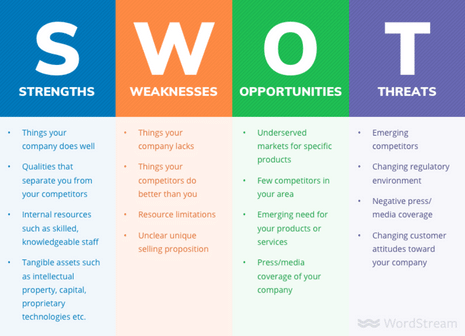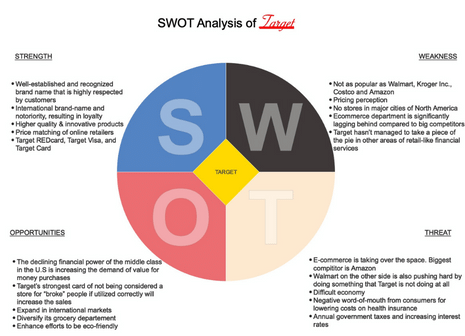What is SWOT Analysis and How to Do It Accurately?
SWOT analysis of a company using diagrams or patterns is an integral part of any business planning or analysis. It stands for strengths, weaknesses, opportunities, and threats. While strengths and weaknesses constitute internal factors, opportunities and threats constitute external factors.
A SWOT analysis template or matrix evaluates a business or company, taking into consideration each of these factors. It primarily contains four boxes, one for each factor, but the shapes depend on the design.
These diagrams are handy when deciding whether or not to go for a particular venture or strategy by evaluating the pros and cons. By breaking down the positives and negatives of a project, SWOT analysis for a small business makes it easier for companies to decide whether or not to choose a strategy.

The SWOT Analysis Process
SWOT stands for Strengths, Weaknesses, Opportunities, and Threats. But what do these mean? Let’s take a look at each SWOT analysis template separately.
Strengths
The first element of SWOT is Strengths. As you have probably figured out, this element highlights things your venture or project does exceptionally well. This could be something subtle such as your company’s brand attributes or something much more easily describable such as the selling pitch of a product. Besides, it could also be your people: a great engineering team, excellent human resources, and strong leadership.
Read: What is thought leadership?
Weaknesses
Once you know your strengths, it’s time to turn your attention to your weaknesses. What’s holding your company back? This element can include business problems such as a lack of skilled professionals and financial or budgetary limitations.
This factor of SWOT analysis may also consist of weaknesses concerning other businesses in the industry, including the lack of a clearly defined USP in a crowded market.
Opportunities
It’s time to direct your self-awareness to the opportunities. For example, do you struggle to keep up with the volume of leads generated by your marketing team? That’s an opportunity.
In short, this factor of SWOT analysis covers everything you could do to improve sales, move forward as a company, or advance your business’s mission.
Threats
The final element of SWOT analysis is Threats — everything that includes a risk to either your company itself or its likelihood of success or growth.
This could include factors such as emerging competitors, monetary risks, changes in regulatory law, and virtually everything else that could potentially thwart the future of your company or project.
External and Internal Factors
The four elements mentioned in the SWOT analysis are common to an extent in all cases. However, a lot of companies further categorize these things into two subgroups: Internal and External.
In reality, Strengths and Weaknesses are considered internal factors, i.e., the result of business decisions under the company or team’s control. So, for example, a high churn rate would be described as a weakness, but improving a high churn rate is still under your capacity, making it an internal factor.
Likewise, emerging competitors would be compartmentalized as a threat in a SWOT analysis, but since there’s only a little you can do about this, which makes it an external factor. This is why you must have seen Free SWOT analysis templates being referred to as Internal-External Analyses or IE matrices.
Subdividing your four primary elements into Internal and External factors isn’t necessarily crucial to the success of your SWOT analysis. Still, it can help identify your next move or assess the level of control you have over a given issue or opportunity.
How to Do a SWOT Analysis
- Determine the Goal: Think about a major project or strategy to evaluate and place it at the top of the page.
- Create a Grid: Draw a big square and compartmentalize it into four small squares.
- Name Each Box: Write “Strengths” inside the top left box and “Weaknesses” in the top right box. On the other hand, write “Opportunities” within the bottom left box and “Threats” inside the bottom right box. You must remember to label each box as they help distinguish it from the rest of the text using either color or font size.
- Add Strengths and Weaknesses: Add elements that affect the strategy to the appropriate boxes. Elements of a SWOT analysis may be qualitative and subjective as well as quantitative and pragmatic in nature. Factors are typically listed in the form of bullets.
- Draw Conclusions: Study the finished SWOT diagram. Make sure that the positive results outweigh the negative ones. If they do, it may be a good decision to carry out the goal. And if not, changes may need to be made, or the plan should be disregarded.

The Bottom Line: Why Your Business Should Conduct a SWOT Analysis
If you’re a small business owner or an independent marketer, you might be wondering if the SWOT analyses are feasible or even practical for smaller businesses. Even though there is resource transparency involved in developing a SWOT analysis, there are many benefits, even for the smallest of companies.
For one, undertaking a SWOT analysis provides an excellent opportunity to gain greater and deeper insights into how your company operates. It’s all too easy to get lost in your work, and conducting a SWOT analysis is a great way to evaluate your company’s objective with a bird’s eye, as well as the position it occupies in your industry.
Another significant benefit of Swot analysis is that this method can be applied to a broad range of things, not just as an overview of your business. For example, you could use SWOT analysis to study an upcoming marketing campaign’s potential strengths and weaknesses, a planned content project, or even represent your business at a trade show or industry event.
It almost goes without mentioning that undertaking a SWOT analysis allows you to determine what your business does well, where there’s room for improvement, and the opportunities and threats facing your business.
In any case, using a Free SWOT analysis template gives you a chance to recognize these factors and build and implement concrete road maps and timelines for potential solutions. This can be useful in developing financial plans, identifying hiring needs, and other mid-to-long-term strategic planning.
Share this
You May Also Like
These Related Stories

Google's 2024 Update: Key Takeaways for Online Reputation Management

9 Strategies for Building a Positive Company Reputation


